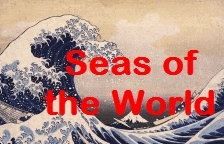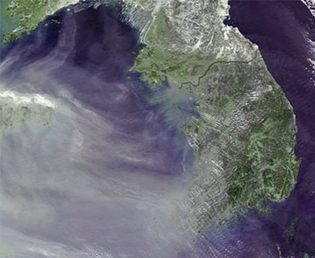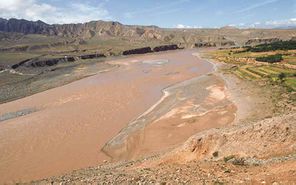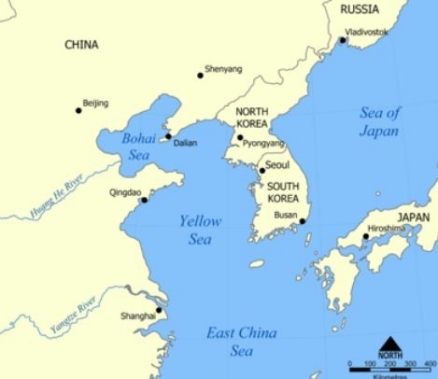Yellow Sea
Seas of the World  The Yellow Sea is a marine water body bordered by China to the north and west, and by North and South Korea to the east. At the south it merges with the East China Sea.
The Yellow Sea is a marine water body bordered by China to the north and west, and by North and South Korea to the east. At the south it merges with the East China Sea.
The Yellow Sea receives extensive water pollution loading from its riverine influxes as well as from intensive traffic. As a result of this water quality impact suite and overfishing to support the large human population of the region, there is an issue of ongoing eutrophication and habitat degradation throughout the basin.
The Yellow Sea Basin is also a locus of increasing concern regarding air quality deterioration, due to the massive emission growth on the Chinese mainland; Boyer and Howarth note that the air pollution emission load of east Asia will exceed that of North America and Europe combined due to the enormous quantity of low quality fossil fuel being burned and projected to be burned to support the Chinese and North Korean energy industries.
Contents
Geography and hydrography
 Yellow Sea from space, showing smog from China moving east. Source: NASA The limits of the Yellow Sea are set forth by the International Hydrographic Organization as follows:
Yellow Sea from space, showing smog from China moving east. Source: NASA The limits of the Yellow Sea are set forth by the International Hydrographic Organization as follows:
- At the south. The parallel of 33°17' northward from Saisyu To Quelpart, thence to the Chinese mainland .
- At the southeast. From the Western limit of Quelpart to West Pinnacle Island (34°13'N) in the Mengoru Group, thence to the northernmost point of Oku To (34°22'N), thence to the westernmost point of Small South Stone Island and the northernmost point of Great South Stone Island (34°24'N) to a point on the coast of Tin To (34°25'N) along the northwest coast of this island to its northernmost point, and thence on a line in a northeasterly direction to the mainland of the Korean Peninsula.
The eastern coastal zone of the Yellow Sea is notable for its broad, silty and gently sloping margin, resulting in extensive intertidal mudflats covering much of the Korean Peninsula coastline. At the northern end of the Yellow Sea are two gulf bodies: Bohai Bay and the Bay of Korea.
Water quality
There are significant issues of water quality in the Yellow Sea Basin; these impacts stem from polluted riverine discharges from China and North Korea, as well as the sheer intensity of shipping traffic within the basin, leading to ongoing bilge pumpout and fuel spillage incidents. Outbreaks of harmful algal blooms have increased along the Yellow Sea coastal waters, particularly near the islands, and in areas where massive public works projects such as dams and dikes have been enplaced. Many of these public projects restrict water circulation and cause losses to the aquaculture industry.
 Yellow River, a major tributary to the Yellow Sea, carries a heavy load of nitrate and sediment along the Quinghai Plain.
Yellow River, a major tributary to the Yellow Sea, carries a heavy load of nitrate and sediment along the Quinghai Plain.
According to analyses of Boyer and Howarth, typical annual nitrogen input to the Yellow Sea in the late 1990s was approximately 1229 kilotonnes per annum, with a residence time for nitrogen of about one and a half years; this implies an effective doubling time for nitrogen in Yellow Sea waters of three years. The result of this heavy nitrogen loading is excessive water pollution and eutrophication in the Yellow Sea Basin.
The quality of human health is notably poor in the coastal zones, with unsanitary conditions on many beaches, as well as contaminated fish and sea products.
China and the two Koreas have very large populations living in the Yellow Sea drainage basin; these populations are the source of considerable riverine runoff loads of nitrate and sediment, stemming from industrial and agricultural activity.
Many environmental problems are of a trans-national nature: industrial wastewater containing water pollutants from port cities; non-point source contaminants of agricultural origin (pesticides and herbicides); oil discharged from vessels and ports.
Many marine resources are threatened by these sources of pollution as well as by loss of biomass and biodiversity
Marine ecology
See main article: Yellow Sea large marine ecosystem
The Yellow Sea is a significant marine biological resource, supporting substantial populations of fish, invertebrates, marine mammals and seabirds. It is considered a Class I, highly productive (>300 grams carbon per cubic meter per year) ecosystem based on global primary productivity estimates. The dominant phytoplankton species are Skeletonema costatum, Coscinodiscus, Melosira sulcata, and Chaetoceros. The dominant zooplankton species are Sagitta crassa, Calanus sinicus, Euphausia pacifica, and Themisto gracilipes.
The Yellow Sea has clear seasonal variations and supports both cold temperate species (eel-pout, cod, flatfish, Pacific herring) and warm water species (skates, gurnard, jewfish, small yellow croaker, spotted sardine, fleshy prawn, southern rough shrimp). It includes mammalian species such as whales, fin-less porpoise, seals and sea cow lions. Natural fluctuations in the recruitment of some species have led to reductions in body size and trophic level of catch in this marine basin.
References
- M.A.Barter. 2002. Shorebirds of the Yellow Sea: importance, threats and conservation status. Wetlands International Global Series Vol. 9. International Wader Studies Vol. 12. Canberra ISBN 9058820092
- Elizabeth W. Boyer, Robert W. Howarth. 2002. The nitrogen cycle at regional to global scales. books.google.com 519 pages
- International Hydrographic Organization. 1953. Limits of Oceans and Seas, 3rd edition.
- J.Lee. 1977. Estimation of the age composition and survival rate of the yellow croaker in the Yellow Sea and East China Sea. Bull. Fish. Res. Dev. Agency, Busan, 16:7-31.
- X.Lui. (ed.) 1990. Investigation and Division of the Yellow Sea and Bohai Sea Fishery Resources. Beijing, China: Ocean Press.
